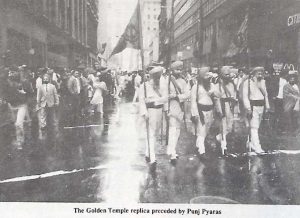

NEW YORK: For the first time in history, the Metropolitan canvas of Manhattan — World’s political and financial nerve center was marked by a spectacular Vaisakhi parade (Nagar Kirtan) which was sponsored by the Sikh Cultural Society of New York in collaboration with Garden State Sikh Association, Gurdwara Bridgewater, Sri Guru Singh Sabha, Glen Rock, N.J., MidHudson Sikh Cultural Society, Fishkill, N.Y, Singh Sabha of New York, Flushing, N.Y., Sikh Center, Flushing, N.Y., and Guru Ram Dass Ashram, Brooklyn, N.Y. More than 10,000 Sikhs joined the parade, braving heavy downpour and chilly winds. The jathas came from as far away as California, Chicago, Toronto, Boston, Washington, D.C. and other major towns in the TriState area. A large contingent of American Sikhs dressed in their usual immaculate white was quite conspicuous amidst a surging sea of kesari turbans and dupattas.
The float depicting a replica of the Golden Temple was the star attraction of the parade. “We want to tell people of the importance of the Golden Temple”, said Baldey Singh, Secretary Sikh Cultural Society of New York. He compared its significance for Sikhs to that of the Wailing Wall for the Jews or of St. Peters for the Catholics or of the Mecca for the Muslims. The Golden Temple float was followed by one carrying Sri Guru Granth Sahib. There were other floats depicting village scenes in Punjab. Women and men danced separately on the flatbed trucks.
Vaisakhi holds a special significance for the Sikhs as on this day on March 30. 1699. The tenth prophet of the Sikhs, Guru Gobind Singh created the order of the Khalsa. It is celebrated all over the world by the Sikhs as the birthday of the Khalsa adn in keeping with the sanctity of the occasion; hymns from the Holy Scripture were continuously recited by the Ragi jathas.
The Parade started from the 38th street, moved down Broadway through Herald Square in Manhatten and culminated at the Union Square Park on 14th Street where lunch was served by Kabul Sikhs and soft drinks were served by the Nanak Taxi Association. Religious and martial poems were recited at the Assembly there and a resolution was passed appealing the Singh Sahib Jasbir Singh KhaIsa, Jathedar Akal Takht Chief and other Singh Sahibs to strive with all sincerity to accomplish the task of establishing a sovereign Sikh homeland and not to compromise on anything less than Khalistan”. The resolution proposed by Baldev Singh and seconded by Prof. Manjeet Singh Sidhu was passed with resounding jaikaras.
The distinctive feature of the parade was the perfect discipline displayed by the participating Sikhs especially in view of the inclement weather. Talking to World Sikh News, the Chairman of the Coordinating Committee, S. Jagjit Singh Mangat said that the parade would henceforth form an annual feature and would be organized in far more impressive style than this year.
The Attorneys defending Ranjit Singh Gill and Sukhminder Singh Sandhu who are facing extradition proceedings against them also joined the parade. Mr. Kunstler congratulated the Sikhs for organizing such an impressive show on the occasion of the Birthday of the Khalsa. Ronald Kuby talked about the “police raj” in Punjab and said that human rights were practically nonexistent for the Sikhs in India. He disclosed that he was not allowed to visit Punjab when he went to India to collect evidence in support of his clients. He, however, was able to know what was happening to the Sikhs in Punjab which he summed up by saying that Punjab was nothing but a big prison for the Sikhs.
Endorsing Mr. Kuby’s statement Mary Pike hoped that Gill and Sandhu would in all probability is “with you here particularly in the next Parade as free men”.
Article extracted from this publication >> April 29, 1988

